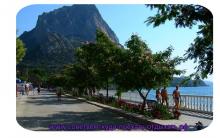Animation map of events for the last 3 hours.
- Click on the map above. Opens in a new window, the latest release, can be scaled up to 1500x1100 px.
- Daily updated map of weather phenomena based on data from radar complexes of the observation network of Roshydromet, Ukraine and Belarus. Animation (animated map) current data radar observations for ETR → weather phenomena for the last 3 hours (see almost in real time). If the map has not loaded here, then click on the link
»Animated map of weather phenomena for the last 3 hours - Another "MORE VISIBLE" animation map of all weather phenomena in the European territory of Russia (ETR) in real time
»Animated map of meteorological phenomena of the DMRL for the last 3 hours
Above was, let's say, a "global" map of weather phenomena, including the entire European territory of Russia.
Now go to the map at a different URL »DMLR map
 On this map there will be areas marked gray color and, when you hover over which, the cursor should change.
On this map there will be areas marked gray color and, when you hover over which, the cursor should change.
If the location you are interested in falls into such places on the map, then you can familiarize yourself with current weather events in this region (at the top will be the date and time of the image).
On the "DMRL map" set "cursor" to the desired city or any selected place, click on it with the left mouse button (see the picture on the left).
For clarity, below is a screenshot of the map, i.e. what image you will get.
In the picture you will find all the symbols of weather phenomena, etc.

The first radar stations, which came to meteorologists after the war, could only detect cumulonimbus clouds with dangerous phenomena. Several decades were spent on their modernization and the development of measuring circuits that could extract information not only from the height of the radio echo, but also from the results of signals reflected from the clouds. The ability to observe the appearance of dangerous phenomena, calculate their speed and direction of movement for a long time allowed the IRL to take a leading position in storm warning.
The meteorological radar has been an indispensable instrument for detecting phenomena that accompany convective clouds - thunderstorms, hail, showers, squalls for 60 years.
Meteorological incoherent radars determine OH (hazardous phenomena) by indirect signs - measurements of the height of the upper boundary of the radio echo and the reflectivity of cumulonimbus clouds, and make a decision using radar hazard criteria.
The method of radar interferometry is indispensable for the timely detection of displacements of the earth's surface over areas of underground mining, mapping deformations of the sides and ledges of quarries, as well as for monitoring natural and man-made displacements and deformations of structures.
Radar interferometry detects the smallest displacement - down to a few millimeters, minimizes the risk of emergencies and significantly reduces their possible consequences.
The main advantage of radar interferometry is independent remote assessment of changes over the entire image area. For the calculation, an array of satellite radar data obtained with a frequency of up to 8 times a month is used.
Radar monitoring of displacements and deformations takes place in two stages:
1. Planning and ordering of target multi-pass radar satellite imagery.At this stage, it is necessary to obtain the initial array of radar observations - 30 radar surveys for 30 different dates.
Radar data can be collected for 5-6 months (for monitoring intense displacements up to 1 meter per year, the period from April to October is ideal) or over several years (suitable for monitoring in cities where displacements are not too intense).
2. Interferometric data processing of multi-pass radar satellite imagery.
At this stage, maps of displacements and deformations of the earth's surface and structures are calculated from the array of initial data of radar observations.
As a result, the customer receives maps recording changes in the earth's surface and structures as of each date of the survey in vector and raster formats, accompanied by technical reports. Additionally, maps of vertical and horizontal displacements can be calculated, and areal processing of data using the SBas method can be performed, which gives raster files of displacements and displacement isolines at the output.
 |
| Permanent diffusers in the center of Astana. The stable buildings of the house of ministries (center), the Supreme Court (top left), the parliamentary complex and the presidential administration (high-rise buildings in the background) and the residence of the President of Kazakhstan (in the background). Reflectors along the embankment are also stable. |
 |
| An example of monitoring displacements of the earth's surface in the area of \u200b\u200ba gas field and a groundwater field. Based on the results of a 30-pass survey of this area over 6 months (frame area 40 × 40 km), 5,000,000 points were identified - permanent scatterers of the radar signal, for each of which the displacements are known for each shooting date relative to the date of the first survey. |
 |
| Fragment of a raster map of displacements of the earth's surface in color coding. In pixel - the values \u200b\u200bof the displacement of the earth's surface in millimeters. Negative values \u200b\u200bcorrespond to subsidence, positive values \u200b\u200bcorrespond to uplifts. Isolines of displacements are drawn along pixels with equal displacement values. |
We are glad to announce that in the Kirov Center for Hydrometeorology and Environmental Monitoring since 01.04.2016 a new generation meteorological device has been introduced and is successfully operating. Doppler meteorological radar (DMRL-S).
The DMRL-S radars are installed by Roshydromet on the territory of the Russian Federation in order to create a unified system of radar meteorological observations of Roshydromet. In total, it is planned to install about 140 DMRL-S radars by 2020.
Today, remote Doppler meteorological radars with polarization signal processing for the operational services of Roshydromet and aviation forecasters are a unique means of meteorological observations, because allow in real time to track information about the location and movement of mesoscale cloud formations, the occurrence of zones of intense precipitation, to fix the zones of dangerous phenomena, including thunderstorms, hail, squalls, to monitor their development and movement. Modern DMRL-S have a viewing radius of 250-300 km and allow cyclic observations with a frequency of 3 to 15 minutes in a round-the-clock automated mode, providing data with a high spatial resolution (0.5-1 km) over an area of \u200b\u200bup to 200 thousand km2.
The radar information of the DMRL-S radars well complements the data of meteorological satellites, which use passive methods for sounding the atmosphere, but unlike them, the software specially developed for the DMRL-S radar (software VOI "GIMET-2010") makes it possible to process and interpret radar information. In addition, it allows you to correlate meteorological phenomena on the DMRL-S map with the synoptic situation.
"GIMET-2010" builds a three-dimensional model of cloudiness parameters, the mathematical processing of which provides the construction of the following radar maps and meteorological characteristics:
1) maximum reflectivity in a layer above 1 km,
2) HBGO - the height of the upper cloud limit;
3) meteorological phenomena;
4) dangerous meteorological phenomena;
5) intensity of precipitation;
6) accumulated amounts of precipitation;
7) integral water content of clouds, VIL;
8) NNGO - the height of the cloud base;
9) vertical and horizontal wind shears;
10) turbulence;
11) visibility in precipitation;
12) contours of dangerous phenomena;
14) vertical wind profile VW;
15) nanohandles of the horizontal wind vectors HW to any r / l map.
Access to digital maps of observations of meteorological radars in the display system of the single radar field of the DMRL-S network of Roshydromet is already available on the Internet at the website meteorad.ru, but the information on it is presented with a delay of 24 hours.
For local consumers of DMRL-S information, the transfer of secondary r / l products to remote Subscriber Points (AP) over the local network is provided in real time on a contractual basis.
|
Figure 1 Automated workstation "Client DMRL-S" |
The most obvious and, as practice shows, the demanded product of the DMRL-S are maps of meteorological phenomena, which will be of interest, first of all, for services whose activities are related to the adoption of operational decisions: the Ministry of Emergency Situations, ATC, traffic police, municipal and transport departments, agricultural, energy and construction industries, industries whose individual technological processes depend on weather conditions. Meteorological radar information will most likely allow identifying areas of occurrence of phenomena dangerous for the industry, planning and adjusting work, and ensuring its safety. Reducing damage from dangerous weather phenomena, thereby, will allow you to get additional profit. |
There is experience in using information from DMRL-S in other regions.
For organizations interested in receiving specialized information from the DMRL-S on-line, the Kirovsky TsGMS organizes, on a contractual basis, an automated data transfer, both in digital form for subsequent processing, and in the form of a screenshot (picture).











Naruto storm 4 sees gamepad
Now on the map: how the new Yandex
Radar Data Maps Radar Observation Map
Where is Mexico - detailed map of the world with cities in Russian Geographic map of Mexico
Organization of game processes in a multiplayer game Entering another level in a computer game